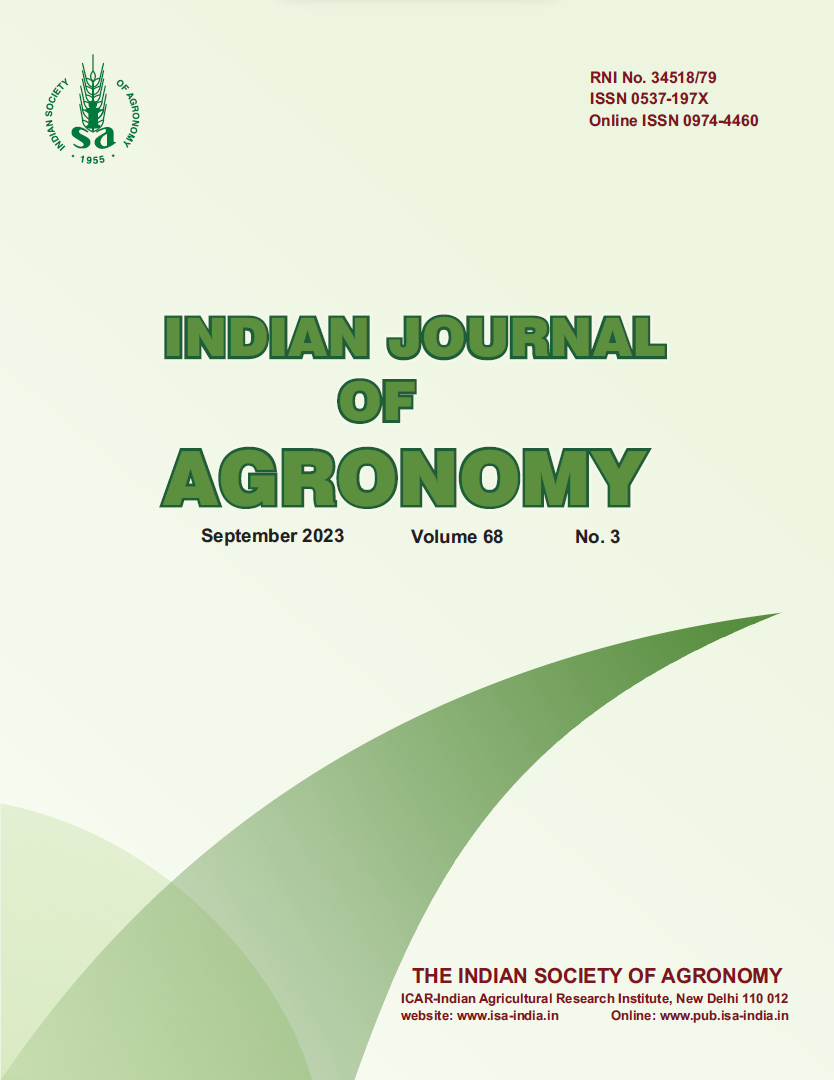Micro-meteorological parameters, growth indices and productivity of barley (Hordeum vulgare) cultivars as influenced by clipping and zinc biofortification
DOI:
https://doi.org/10.59797/ija.v68i3.2807Keywords:
Barley, Clipping, Micro-meteorological, Normalized difference vegetative index, Transpiration rateAbstract
A study was carried out during the winter (rabi) season of 2015–16 and 2016–17 at Punjab Agricultural University, Ludhiana, to assess the effect of different barley (Hordeum vulgare L.) cultivars (2- and 6-row) on micro-meteorological parameters, growth indices, photosynthetic parameters and productivity of barley (Hordeum vulgare L.) in relation to different clippings time along with Zn foliar application. The results indicated that cultivar ‘DWRUB 52’ intercepted more photosynthetically active radiation (PAR) than ‘PL 807’ and ‘PL 426’, whereas, normalized difference vegetative index (NDVI) values of ‘DWRUB 52’ and PL 807 were statistically similar and significantly better than ‘PL 426’. Cultivar ‘DWRUB 52’ showed the highest absolute growth rate (AGR) and crop-growth rate (CGR), followed by ‘PL 807’ and ‘PL 426’ during both the years of study. Cultivar ‘DWRUB 52’ gave 6.0 and 18.7% higher grain yield than ‘PL 807’ and ‘PL 426’ respectively. Foliar application of Zn at anthesis and early milk stages enhanced the PAR and NDVI, AGR, CGR and RGR at 90–120 days after sowing (DAS) and at 120 DAS to maturity. Foliar application of Zn with both clippings, i.e. 50 and 60 DAS resulted in the statistically similar transpiration rates and were significantly higher than the other treatments. There was an increase of 12.6% in grain yield when clipping was done at 50 DAS with foliar application of Zn and an increase of 8.9% in grain yield when clipping was done at 60 DAS with foliar application of Zn than control crop.
References
Cakmak, I., Pfeiffer, W.H. and McClafferty, B. 2010. Biofortification of durum wheat with zinc and iron. Cereal Chemistry 87: 10-Dhillon, B.S. and Uppal, R.S. 2019. Influence of cutting management on photosynthetic parameters, heat use efficiency and productivity of barley (Hordeum vulgare L.) under variable sowing dates. Journal of Agrometeorology 21(01): 51-57.
El-Shatnawi, M.K.J. and Haddad, N.I. 2004. Assessing barley (Hordeum vulgare ) response to clipping in the semi-arid Mediterranean Climate. Australian Journal of Experimental Agriculture 44: 34-42.
El-Shatnawi, M.K.J., Ghosheh, H.Z., Shannag, H.K. and Ereifej, K.I. 1999. Defoliation time and intensity of wall barley in the Mediterranean Rangeland. Journal of Range Management 52: 258-262.
Fu, X.Z., Peng, L.Z., Xing, F., Ling, L.L., Chun, C.P., Jiang, C.L. and Cao, L. 2014. Zinc deficiency in citrus: Current studies and future perspectives (in Chinese). International Journal of Fruit Science 31: 132-139.
Fu, X.Z., Xing, F., Cao, L., Chun, C.P., Ling, L.L., Jiang, C.L. and Peng, L.Z. 2016. Effects of foliar application of various zinc fertilizers with organosilicone on correcting citrus zinc deciency. HortScience 51: 422-426.
IIWBR. 2021. Progress Report of AICRP on Wheat and Barley 2020-21: Barley Improvement. Eds: Verma, R.P.S., Kharub, A.S., Kumar, D., Lal, C., Singh, J., Malik, R., Kumar, L., Bishnoi, S.K., Kumar, S., Bhardwaj, S.C., Jasrotia, P., Verma, A., Sharma, A.K., Singh, C., Singh, S. and Singh, G.P. ICAR-Indian Institute of Wheat and Barley Research, Karnal, India, pp 244.
Jan, A., Wasim, M. and Jr. A. 2013. Interactive effects of zinc and nitrogen application on wheat growth and grain yield. Journal of Plant Nutrition 36: 1,506-1,520.
Jat, L.N. and Singh, S.M. 2003. Growth, yield attributes and yields of wheat (Triticum aestivum) under different planting pattern or cropping systems and varieties. Indian Journal of Agronomy 49: 41-43.
Kapil, U. and Jain, K. 2011. Magnitude of zinc deficiency amongst under five children in India. Indian Journal of Pediatrics 78: 1,069-1,072. Kaur, G. 2007. Effect of row spacing and time of cutting for forage on productivity of barley varieties/genotype in dual purpose production system. M.Sc. Thesis, Punjab Agricultural University, Ludhiana (unpublished)
Kaur, K. and Singh, H. 2012. Studies on yield, chlorophyll content and nitrogen uptake of barley varieties as influenced by levels and time of nitrogen application. Progressive Agriculture 12: 386-391.
Mal, T. 2013. Response of barley Chordeum vulzare. Serotypes to different nitrogen levels under irrigated late sown conditions. M.Sc. Theses, CCSHAU, Hisar (unpublished)
Marschner, H., Kirkby, E.A. and Cakmak, I. 1996. Nutrition of higher plants. Journal of Experimental Botany 47: 1,255- 1,262. Radford, P.J. 1967. Growth analysis formulae-their use and abuse. Crop Science 7: 171-175.
Singh, M.V. 2009. Micronutrient nutritional problems in soils of India and improvement for human and animal and human health. Indian Journal of Fertilizers 5: 11-16.
Srivastava, A.K. and Singh, S. 2009. Zinc nutrition in ëNagpurí mandarin on Haplustert. Journal of Plant Nutrition 32: 1,065-1,081.
Yeo, R.B. and Flower N.P. 1984. Response of dwarf durum and aestivum wheat varieties to nitrogen. Indian Journal of Agronomy 29(3): 341-350.






